This Creamy Ethiopian Berbere Chicken Curry is super easy, and takes just a few minutes of prep work! It’s deeply flavored with the chili spice mix that makes it taste like you spent hours in the kitchen, but there are only a few simple ingredients. It’s naturally gluten-free and dairy-free, and perfect served with freshly steamed rice or cauliflower rice.
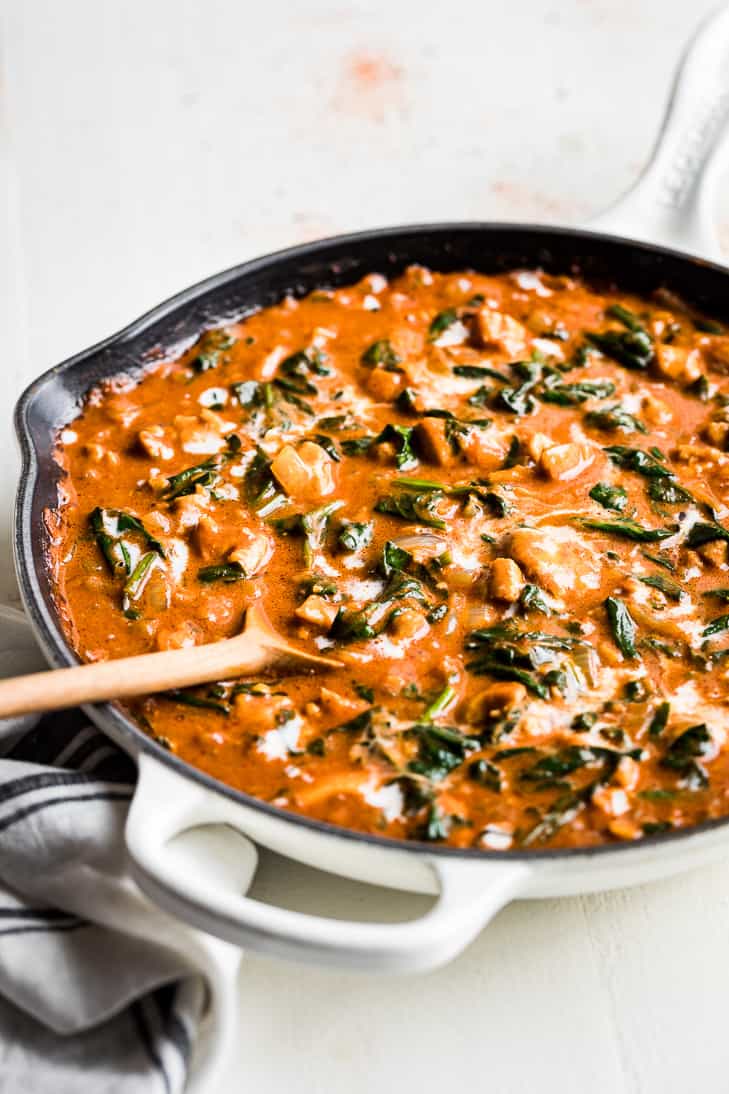
Have you tried Ethiopian Berbere spice mix yet? If not it’s more than worth a few minutes to track some down because it’s incredibly flavorful! You can also put together curries and stir fries in just minutes because all the spices are conveniently mixed together, and ready to go for you.
Watch How To Make Creamy Ethiopian Berbere Chicken Curry
You can check out below where I get my spice mix, but first, let’s talk about this curry shall we? It’s perfectly creamy as you might expect from a coconut curry.
I love the flavors of Ethiopian Berbere and it makes a wonderful Ethiopian-inspired curry. Berbere curries are usually tomato-based. But I think you’ll find you love the combination of both tomato and coconut milk to make it creamy yet still dairy-free.
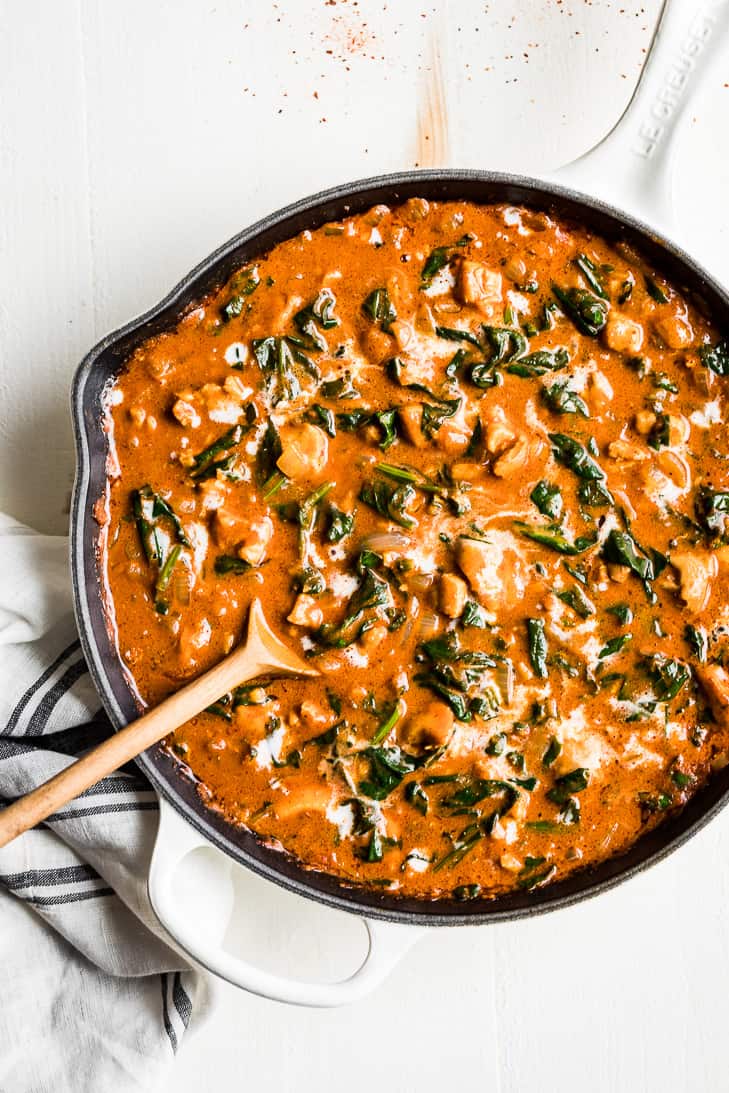
It’s perfectly flavored with a mix of onions, garlic, and ginger that compliments the berbere spice mix. And for a veggie, I added in loads of roughly chopped fresh spinach right at the end for an easy way to add more greens to your diet.
Also, I have so many packages of frozen greens in my freezer I put up from our Farmer’s Market last year that I need to use. So I’ve been creating curry recipes to make good use of all those frozen greens.
Let’s get started making this Creamy Ethiopian Berbere Chicken Curry
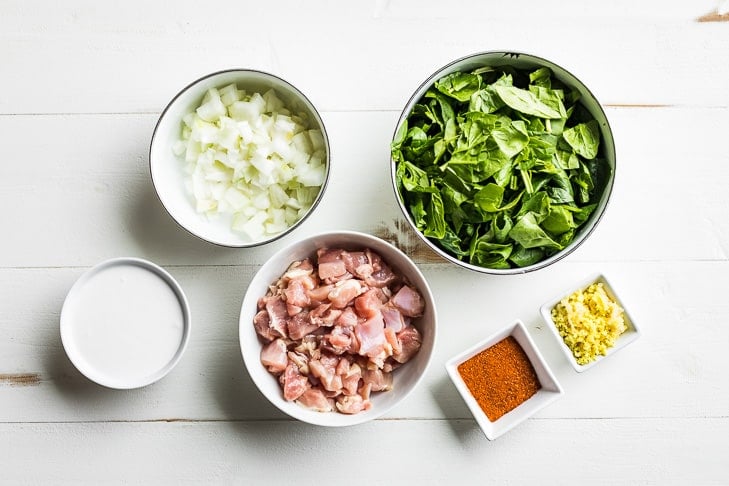
Step 1: Start by prepping all of your ingredients. This recipe comes together pretty quickly, then just simmers for a bit. So it’s best to have everything ready to go!
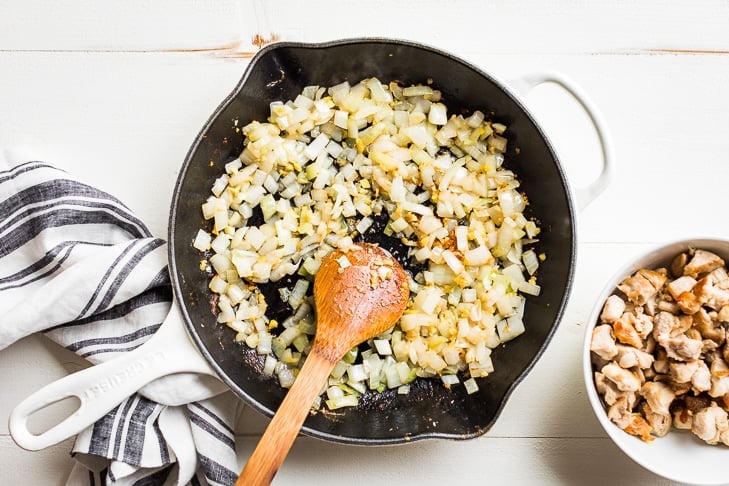
Step 2: Next, we’re going to sauté the chicken, then remove it from the pan, and set it aside in a bowl.
Then after the chicken has been sautéed, we’re going to cook the onion together with the garlic and ginger over medium-low heat until softened.
Tip: Use ground chicken, turkey, or pork in place of the chicken thighs to speed things up. When you use ground meat you get to skip cutting up raw meat! This is one of my favorite ‘busy night’ dinner tricks.
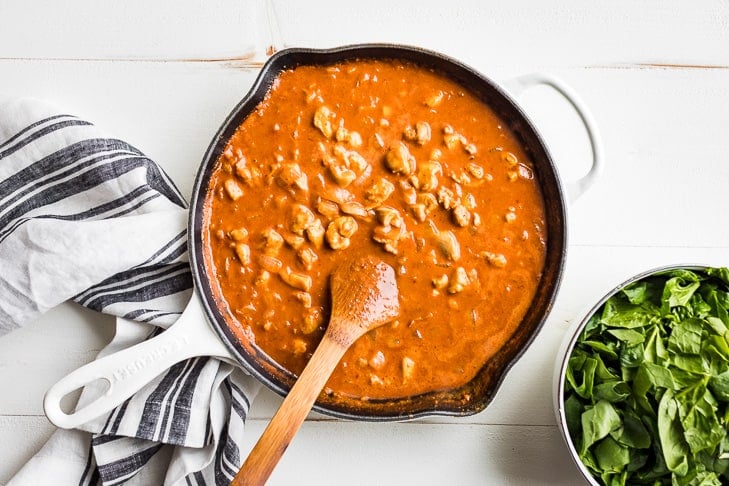
Step 3: From there it’s time to add the spice mix, tomato sauce, and coconut milk. Bring the curry to a boil, then lower the heat to a simmer and cook until the flavors meld, about 10-15 minutes.
This step helps the onion, garlic, and ginger flavors to infuse the curry and make sure there’s no crunch of partially cooked ginger.
Then we’ll add the chicken back to the pan, and cook for a couple of minutes, or until just done.
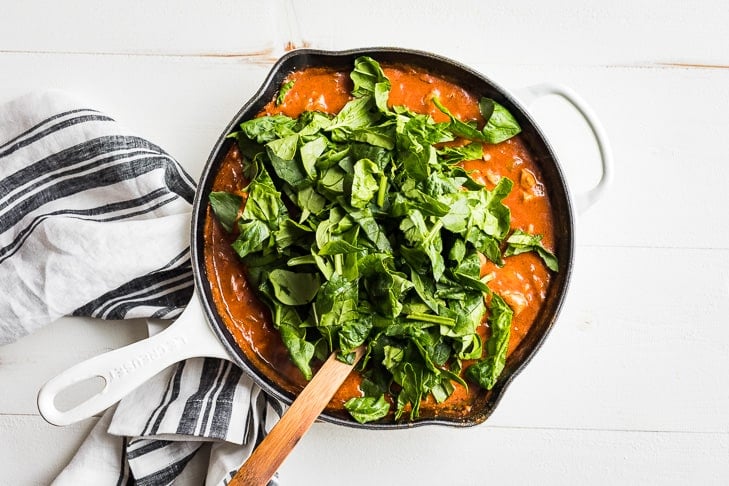
Step 4: And finally, it’s time to add the chopped fresh spinach, (or frozen chopped greens that you like). It’s definitely a lot to add to the pan. So spread it out and allow it to slightly wilt before you mix it in!
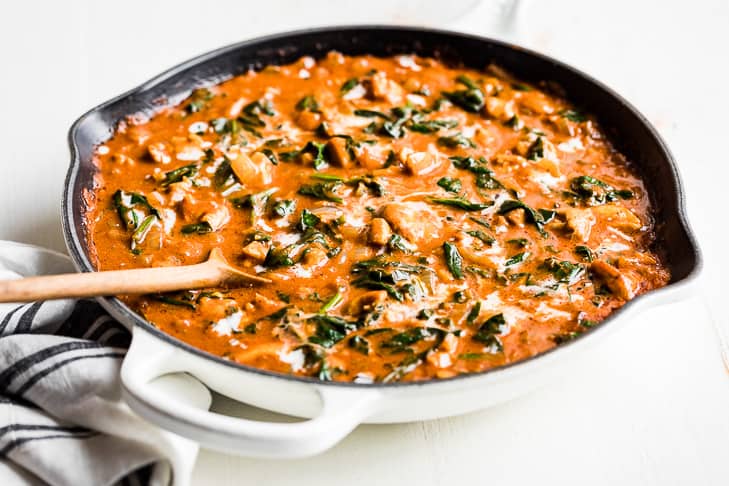
After the spinach has just wilted, taste and adjust the sea salt and serve!
Ways to serve this
- We love this with freshly steamed rice, but you can use cauliflower rice, or even roasted spaghetti squash as well for another grain-free option.
- Add another veggie with my Oven Roasted Broccoli, Perfect Roasted Asparagus, or Sautéed Green Beans.
FAQ’s
Storing leftovers
- To store – place your leftover berbere curry into an airtight container and refrigerate for up to 4 days.
- Make ahead – this curry reheats well, just be sure to overcook the chicken.
- Reheating – place the curry into a saucepan or large skillet and heat over medium heat until heated through.
- To freeze – freeze any leftovers in an airtight container for up to 3 months. Defrost in the fridge overnight before reheating.
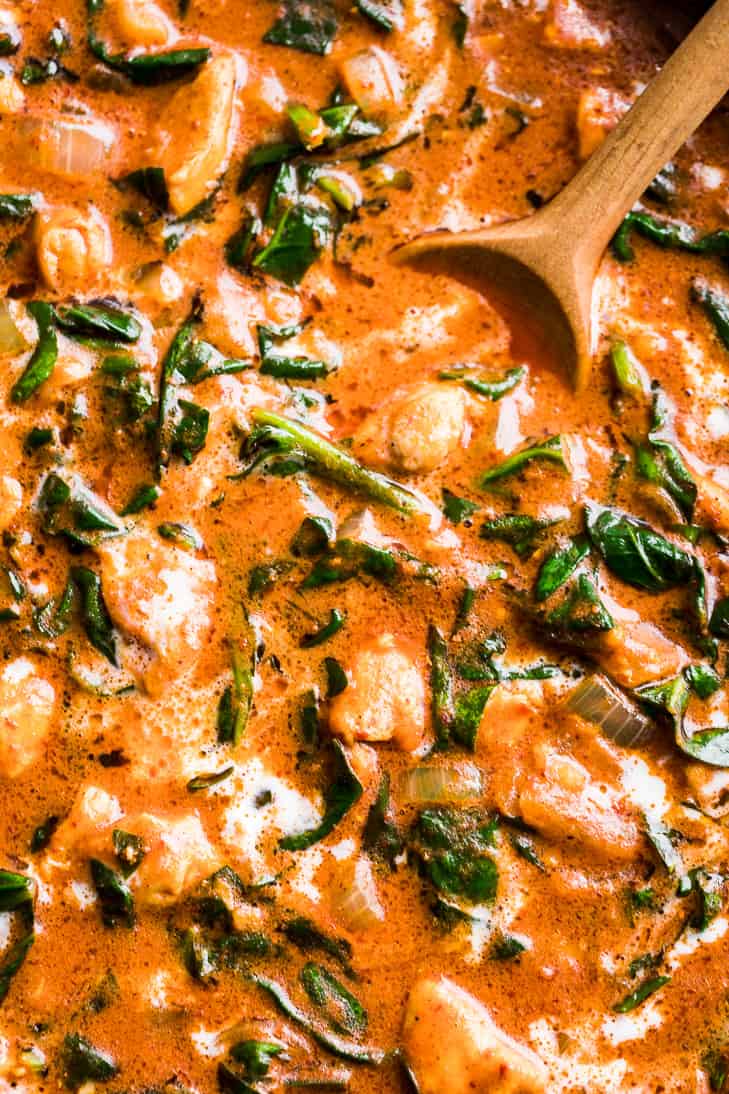
Coconut Curry Recipe inspiration
And lastly if you’re looking for something else to do with berbere spice, check out my Ethiopian Berbere Chicken and Veggie Stir Fry!
I sure hope you get a chance to make this curry soon. And if you do, I hope you’ll leave me a comment/rating below. I always love hearing from you here in the comments. And also over on Instagram where you can tag me at #getinspiredeveryday with your photos!
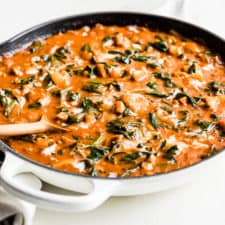
Creamy Ethiopian Berbere Chicken Curry
INGREDIENTS
- 1 pound boneless - skinless chicken thighs, cut into 1/2″ pieces
- 2 tbsp avocado oil
- 1 yellow onion - finely diced, 2 cups
- 1 clove garlic - minced
- 1 tbsp minced fresh ginger
- 2 tbsp berbere spice mix - to taste, see notes
- 1 cup tomato sauce - plain not seasoned
- 1 can coconut milk - full fat, 13.66 oz
- 5 cups spinach - roughly chopped, 5 ounces
- 1 tsp sea salt - or salt to taste
INSTRUCTIONS
- Prep all the ingredients before you begin cooking. Preheat a 9-10" skillet over medium-high heat. When the pan is hot, add 1 tablespoon of the avocado oil along with the chicken. Sauté until the chicken is beginning to brown and is mostly cooked, 4-5 minutes.
- Remove the chicken from the pan and set it aside. Then add the remaining 1 tablespoon avocado oil to the pan along with the onion, garlic, and ginger.
- Sauté over medium-low heat for 3-4 minutes, or until the onions are beginning to turn translucent. Add the berbere spice mix and stir to combine before adding the tomato sauce and coconut milk.
- Bring the curry to a boil, then reduce the heat and simmer until thickened and the flavors meld about 10 minutes.
- Add the chicken back to the pan along with the spinach. Pile the spinach over the top of the curry, and let the heat of it simmering wilt the spinach for about 1 minute before starting to mix it in. This helps the spinach not to go overboard!
- Once the spinach is just wilted, 2-3 minutes, season to taste with sea salt and serve immediately! Leftovers reheat well on the stovetop.


We are loving this recipe! I’m making it for the second time tonight 🙂
After adopting our daughters from Ethiopia years & years ago, we fell in love with Ethiopian food. It’s delightful to have a more simple, weeknight version of Doro wat — we’re thrilled!!
I’m so happy to hear this, I developed this recipe because we love these flavors too and wanted an easy weeknight version!
This is a favorite in our household!
I’m so glad to hear you have been enjoying it so much!
Great recipe!! Everyone loves it!!
Thanks so much, I’m so glad it’s been such a hit for you!
This tasted delicious , very flavourful and spicy, I added some other vegetables (potatoes and peppers). I blended the Berbere spice myself which is really easy to do.
I’m so glad you enjoyed it and thanks for the idea to try potatoes and peppers!
This is so freaking delicious if you can find some quality berbere spice! I have made it and doubled it and made it again. I love it with rabbit. It is to die for.
So glad to hear you enjoyed it and thanks so much for the tip about using rabbit!